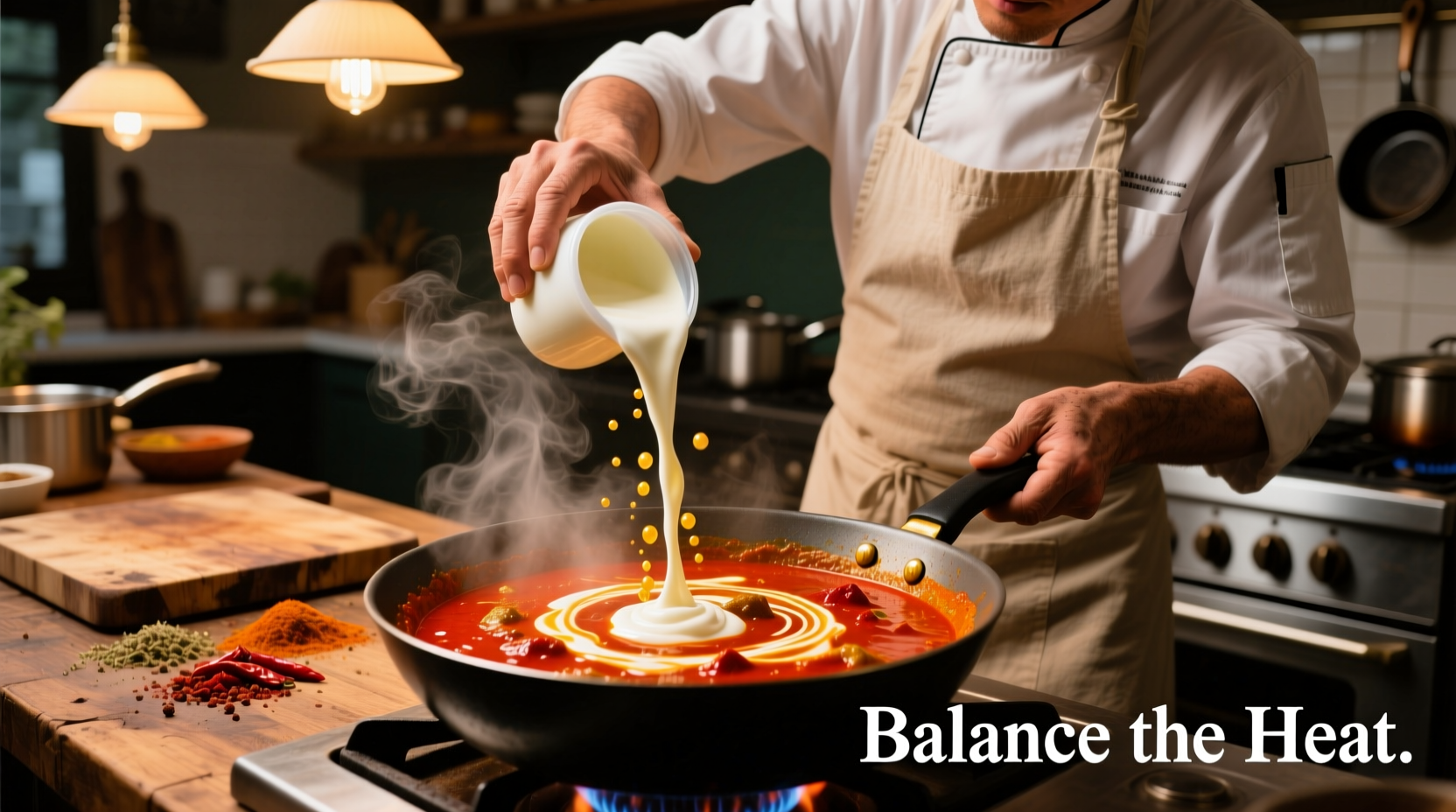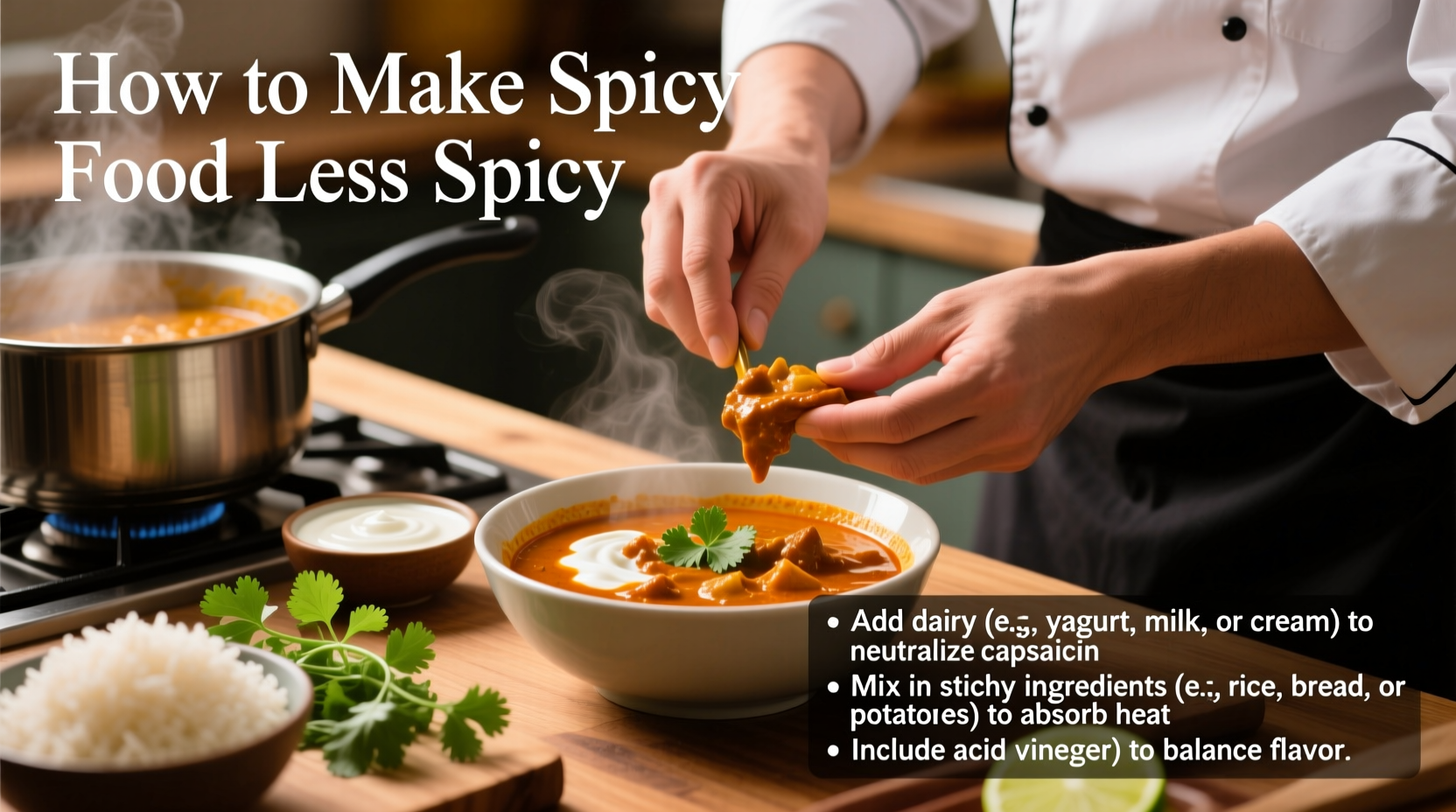Quick Rescue Guide for Overly Spicy Dishes
When your curry, chili, or stir-fry has crossed the line from pleasantly spicy to painfully hot, you need solutions that work now. As a professional chef who's managed spice levels in Michelin-starred kitchens and street food stalls worldwide, I've tested dozens of methods to find what actually works in real cooking situations. This guide delivers proven techniques backed by food science, not kitchen myths.
Why Spiciness Happens (And Why Some Fixes Fail)
Capsaicin, the compound that makes chili peppers hot, is oil-soluble and binds to pain receptors in your mouth. This explains why water often makes spicy food feel worse—it spreads the oil-based capsaicin around your mouth. Understanding this chemistry is crucial for selecting effective remedies. The American Chemical Society confirms that capsaicin's molecular structure responds best to fat, acid, and sugar compounds.
Immediate Fixes for Food Already Too Spicy
When you've already cooked your dish and it's too hot, these methods provide the fastest relief:
Dairy Solutions: The Professional's Go-To Fix
Dairy products contain casein, a protein that breaks the bond between capsaicin and your pain receptors. For immediate results:
- Add plain yogurt (best for Indian and Middle Eastern dishes)
- Stir in sour cream (ideal for Mexican and American recipes)
- Use whole milk or heavy cream (works in soups and sauces)
Pro tip: Add dairy gradually while tasting—1-2 tablespoons at a time—to avoid making your dish too creamy. Never use dairy in Thai or Vietnamese dishes where coconut milk is traditional, as it will alter the authentic flavor profile.
Acidic Counterbalances: Brighten and Mellow
Acids help neutralize the pH imbalance created by capsaicin. The University of California's Food Science Department notes that acids can reduce perceived heat by up to 30% in properly balanced dishes:
- Lemon or lime juice (add 1 teaspoon at a time)
- Vinegar (apple cider works best for most dishes)
- Tomato paste (adds acidity while deepening flavor)
Acid works particularly well in salsas, tomato-based sauces, and Southeast Asian dishes where dairy would be inappropriate.
| Method | Best For | Time Required | Flavor Impact |
|---|---|---|---|
| Dairy (yogurt/milk) | Curries, stews, chili | Immediate | Creates creaminess |
| Acid (citrus/vinegar) | Salsas, tomato sauces | 5-10 minutes | Adds brightness |
| Sugar/honey | Asian stir-fries, sauces | Immediate | Sweetens dish |
| Dilution | All dishes | 15-20 minutes | Waters down flavors |
Sweet Relief: Sugar and Honey
Sugar molecules bind with capsaicin, reducing its intensity. This method works especially well in Asian cuisines where sweet-spicy balance is traditional:
- Add 1/2 teaspoon sugar at a time to stir-fries
- Use honey for depth in barbecue sauces
- Try coconut sugar in Caribbean and African dishes
Be careful with this method—it's easy to over-sweeten. Always add sugar incrementally while tasting.
Dilution Technique: The Safety Net
When other methods aren't working or aren't appropriate for your dish, dilution provides reliable results:
- Add more of the base ingredients (tomatoes, broth, vegetables)
- Incorporate cooked beans or grains to absorb heat
- Double the recipe by adding all ingredients except spices
This method preserves the original flavor profile but requires having extra ingredients on hand. It's particularly useful for large-batch cooking like restaurant service.
Preventative Measures for Future Cooking
Professional chefs avoid spice emergencies through these techniques:
Build Heat Gradually
Add spices in stages rather than all at once. As the CIA (Culinary Institute of America) recommends in their Professional Chef textbook, "spice should be built in layers, with tasting between additions." Start with half your intended amount, cook for 5 minutes, then adjust.
Proper Chili Handling
The heat in chilies concentrates in the seeds and white membranes. Removing these reduces heat significantly while preserving flavor. Wear gloves when handling extremely hot peppers like habaneros or ghost peppers to prevent skin irritation.

Advanced Techniques for Serious Cooks
For those wanting to master spice management:
Create a Balancing Sauce
Mix equal parts yogurt, honey, and lemon juice to create a versatile cooling sauce that complements most spicy dishes without altering their fundamental character. This technique, used in Indian restaurants worldwide, provides customizable heat control at the table.
Temperature Control
Heat perception increases with temperature. Serving spicy dishes slightly cooler than typical serving temperature can make them more manageable. The Food and Drug Administration notes that capsaicin volatility decreases at lower temperatures, reducing its impact on taste receptors.
What NOT to Do: Debunking Spice Myths
Avoid these common but ineffective approaches:
- Drinking water—spreads capsaicin oil rather than neutralizing it
- Adding more salt—enhances heat perception rather than reducing it
- Using baking soda—creates off-flavors and alters texture
These methods might seem logical but actually worsen the problem or damage your dish's flavor balance.
When to Start Over
Sometimes the best solution is to begin again. If you've added too much of an extremely hot pepper (like a Carolina Reaper) or used a concentrated spice extract, no amount of fixing will save the dish. The National Center for Home Food Preservation advises that when capsaicin concentration exceeds 50,000 Scoville units in a dish, remediation becomes nearly impossible without compromising quality.











 浙公网安备
33010002000092号
浙公网安备
33010002000092号 浙B2-20120091-4
浙B2-20120091-4